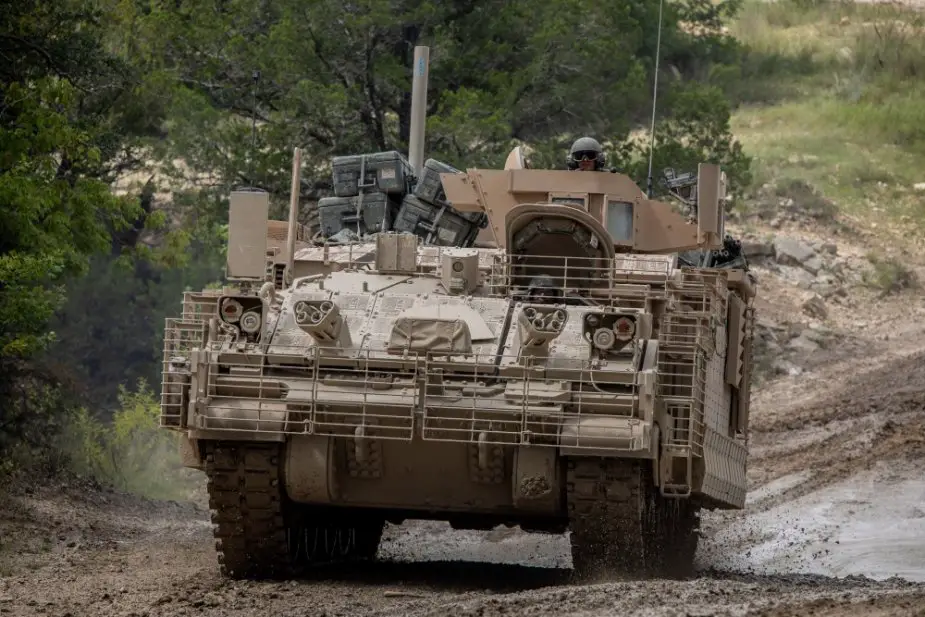Breaking news
US Army completes testing of new Armored Multi Purpose Vehicle.
On September 24, 1st Cavalry Division soldiers completed a two-month program field testing the Armored Multi-Purpose Vehicle (AMPV). 4th Squadron, 9th U.S. Cavalry Regiment "Dark Horse," 2nd Armored Brigade Combat Team teamed up with the U.S. Army Operational Test Command (USAOTC), the Army's only independent operational test organization.

Soldiers from 4th Squadron, 9th U.S. Cavalry Regiment "Dark Horse," 2nd Armored Brigade Combat Team, 1st Cavalry Division, drive through a low-water crossing in the Armored Multi-Purpose Vehicle (AMPV) after completing field testing on Fort Hood, Texas, Sept. 24. (Photo Credit: U.S. Army/Maj. Carson Petry, 1st CAV)
The Army's primary armored fighting force is the Armored Brigade Combat Team (ABCT). The AMPV would replace 5 variants of the M113 Armored Personnel Carrier family of vehicles, which have been in service since the Vietnam-era. AMPV variants tested are: Medical Treatment, Ambulance, General Purpose, Mortar Carriers, and Mission Command. "USAOTC allows the Army to have an independent evaluator for equipment that is being tested," said Maj. Jed Zaffke, a test officer with USAOTC's Maneuver Test Directorate's mounted test division. "We're able to provide feedback to senior leaders to make decisions on that equipment which allows further progression of programs as they field and develop new equipment."
Providing real-time data to developers is USAOTC's shaping operation for the Army. "USAOTC collects data on the material for doctrine, organization, training, materiel, leadership, and education, personnel, facilities, and policy (DOTMLPF-P)," said Bill McKiernan, deputy director/supervisory senior test manager, Maneuver Test Directorate. "We're the link between readiness and modernization. We get the Soldiers and design realistic combat scenarios in conjunction with unit and training developers to see how the system works with a real unit."
USAOTC is the conduit to bring the Army's modernization program to fruition, but not without the Soldier spearheading the effort. The 4-9 CAV was chosen to test the AMPV in a controlled field environment called a limited user test (LUT). "The importance of conducting a limited user test and the process, is it allows the material developer to get feedback from Soldiers in an operational environment," said Zaffke. "It allows them to understand any issues that are negative or positive and be able to refine their platform and provide a better product that meets the needs of the Soldiers going forward."
The AMPV LUT gave Soldiers and leaders the opportunity to provide valuable feedback to the Army's senior leaders while conducting realistic training scenarios in an operational environment. "It's an honor to be chosen to test equipment that may be fielded to the wider force," said Staff Sgt. Pedro Villegas, an indirect fire infantryman with A Troop, 4-9 CAV. "To have input with the developers of the equipment is a tremendous opportunity. I take a lot of pride in being able to do that."
The extensive training program began with issuing the AMPVs to the crews, classroom instruction on its capabilities, driver training, and multiple field exercises. The troopers gained experience maneuvering a new vehicle before the culmination exercise, a series of field tests.
The variants of the AMPV afforded multiple military occupational specialties training time to perfect their battle drills while the headquarters element combined AMPVs to create a mobile mission command center. "We get to mold the Army for the future," said Sgt. Amanda Wilson, a combat medical specialist with Headquarters and Headquarters Troop, 4-9 CAV. "It's giving us time to integrate the new Soldiers and teach them how to set up the main aid station, forward aid station, how to receive patients and evacuate them."
Walking through USAOTC's operations center, the test environment parallels a Combat Training Center (CTC) rotation. Their operations center, filled with subject matter experts and battle track vehicles, sends computer injects through a digital network to create the exercise. Creating realistic scenarios between AMPV operators and the opposing force (OPFOR) gives USAOTC real-time data as Soldiers react according to their tactics, techniques, and procedures.
The 1st Battalion, 5th U.S. Cavalry Regiment "Black Knights" represented the OPFOR, giving 4-9 CAV an adversary to oppose on the simulated battlefield. The training program afforded two 2ABCT battalions valuable training opportunities, increasing brigade readiness through wide-ranging tactical simulations. After each day during the field-testing phase, the unit conducted internal after-action reviews to further improve their readiness. The Soldiers and USAOTC personnel then consolidated AMPVs to download test data. Soldiers conducted focus groups and completed questionnaires to aid in the assessment and improvement phase of field testing. "This training does a lot for our readiness," said Villegas. "With a lot of the new guys we have, it's a great opportunity to get hands-on training. You can't get any better than that."
The U.S. Army Operational Test Command is based at West Fort Hood, Texas and its mission is about making sure that systems developed are effective in a Soldier's hands and suitable for the environments in which Soldiers train and fight. Test units and their Soldiers provide feedback, by offering input to improve upon existing and future systems with which Soldiers will ultimately use to train and fight.
USAOTC's Maneuver Test Directorate tests Armor, Infantry, and robotic systems as well as individual and crew served weapon systems. This includes the accompanying sights, combat uniforms, Soldier load bearing equipment, and personal protective systems for all military occupational specialties. MTD plans and conducts operational tests and reports on Systems-Under-Test in order to inform the evaluation process.


























